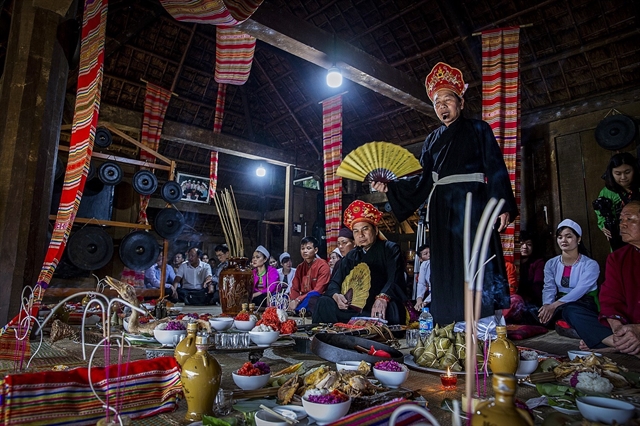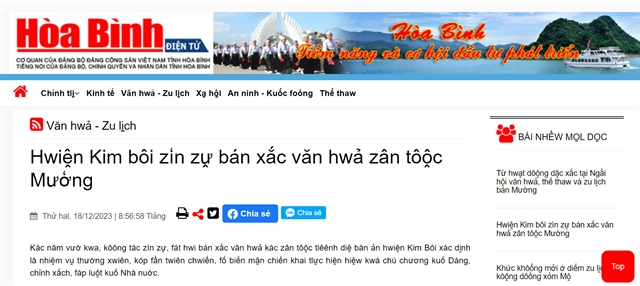By Lê Việt Dũng
HÀ NỘI — In the mountainous areas of Hòa Bình Province where ethnic minorities settle, an “individual of high prestige” is dedicating his efforts to preserve the cultural richness of Mường people.
An “individual of high prestige” is legally defined as someone who earns the trust and respect of the community where he lives, and contributes greatly to public initiatives, from poverty eradication to cultural preservation.
Bùi Huy Vọng is exactly that.
In Lạc Sơn District, he has spent 20 years of his life writing about Mường culture. He has published over 20 books and research papers on Mường shamans, rituals and food.
But his contribution to cultural preservation is not confined to written words. He has also created three YouTube channels with more than 5,000 videos featuring Mường traditional songs, showcasing the great diversity of Mường musical heritages.
“Mường ritual songs are performed on many occasions, from lễ mừng thọ (celebrations of longevity) to lễ mát nhà (ceremonies of pushing away bad luck). They comprise 115 sections and over 44,000 poetic verses, referred to as an Encyclopedia of Folklore for Mường people,” said Vọng.
 |
| Bùi Huy Vọng (right) talking with a local man. — VNS Photo Lê Việt Dũng |
Traditionally, lễ mát nhà is held at the end of a bountiful harvest season to eliminate bad luck and pray for the prosperity of people, crops, and livestock. In the ceremony, a shaman performs ritual songs to summon The Ancient Shaman Khun Khùn Giọt and some other deities, who will enjoy the feast the host offers and get rid of his family’s bad luck in return.
The feast normally comprises sticky rice, fried fish, boiled chicken, fruits, an array of traditional cakes, and the indispensable ingredient – boiled duck. The ceremony cannot go without boiled ducks because Mường people believe that the spirits of the ducks will go to heaven to carry Khun Khùn Giọt to their homes.
Sticky rice, meanwhile, is required to have four colours: white, blue, purple, and red. The first represents Heaven and Earth; the second, peace; the third, the faithfulness attributed to Mường boys and girls; and the last, the hard work it takes to produce the very grains of rice.
 |
| An Mường shaman is performing ritual songs at a ceremony to push away bad luck. — VNA/VNS Photo Tuấn Đức |
The shaman wears a red hat, a black coat and a yellow or purple belt to orchestrate the ceremony. He uses his ritual tools to summon the deities and keep them in bags called khót when it is done. The more khót a shaman has, the more influential he becomes.
“On lunar December 27th, Mường shamans use alcohol to clean their khót and dry them in the sun to seek blessings in the coming year,” said Vọng.
Vọng’s contribution to cultural preservation extends far beyond the archive of Mường songs and ceremonies. In 2016, he took part in a research team to create an Mường alphabet and had it adopted by the province in the same year, leaving a great scriptural legacy for the Mường community.
“I joined a team led by the linguist Nguyễn Văn Khang in 2016 to create a new alphabet for Mường people, which consists of 28 letters and four tone marks,” said Vọng.
Ancient Mường people used Chinese characters to write but the system was so complex that it became unintelligible for later scholars.
After 1945, Mường academics turned to the Vietnamese alphabet as an alternative. The new writing system was quickly gaining popularity as it was simpler and more effective than the Chinese-derived scripts.
However there was a new problem.
While the Vietnamese and Mường share similarities, some Mường phonetic nuances cannot be captured by the alphabet, such as the sound w in wơ̒, underlining the need for a new alphabet to fill the phonetic gap.
“The reliance on the Vietnamese alphabet would compromise the preservation of phonetic nuances that define Mường linguistic identity. The next generations would misread Mường texts if they keep being written in the alphabet,” said Vọng.
His efforts to preserve Mường’s phonetic richness have paid off as Hòa Bình has adopted Resolution No.2295 to formally recognise the Mường alphabet and proceeded with Scheme No.118 to incorporate it into the curriculum within the province.
The provincial Communist Party newspaper – Hòa Bình Điện Tử – has also published its digital editions in the alphabet, in addition to Vietnamese and English.
 |
| A screenshot of an entry on Hòa Bình Điện Tử which is written in the Mường alphabet. — VNS Photo Lê Việt Dũng |
Vọng’s life work has served as a reminder that cultural preservation requires not only a commitment to the past but also an active engagement with the present and a vision for the future. — VNS
- Reduce Hair Loss with PURA D’OR Gold Label Shampoo
- Castor Oil Has Made a “Huge” Difference With Hair and Brow Growth
- Excessive hair loss in men: Signs of illness that cannot be subjective
- Dịch Vụ SEO Website ở Los Angeles, CA: đưa trang web doanh nghiệp bạn lên top Google
- Nails Salon Sierra Madre
 VnExpress News The News Gateway of Vietnam
VnExpress News The News Gateway of Vietnam





